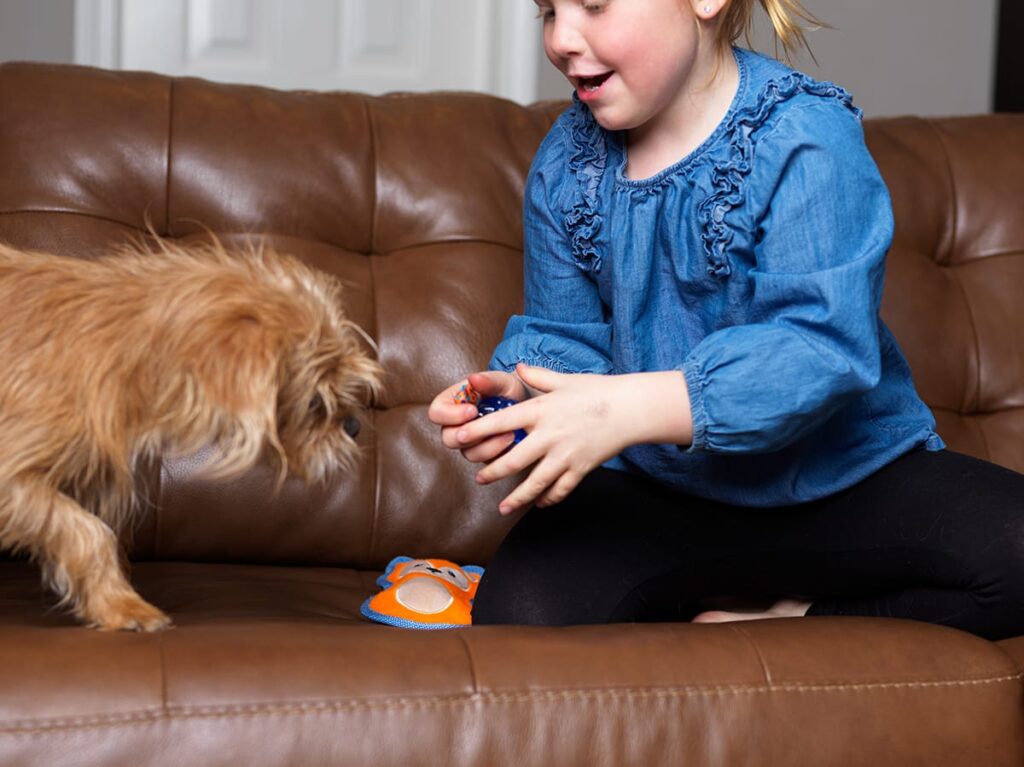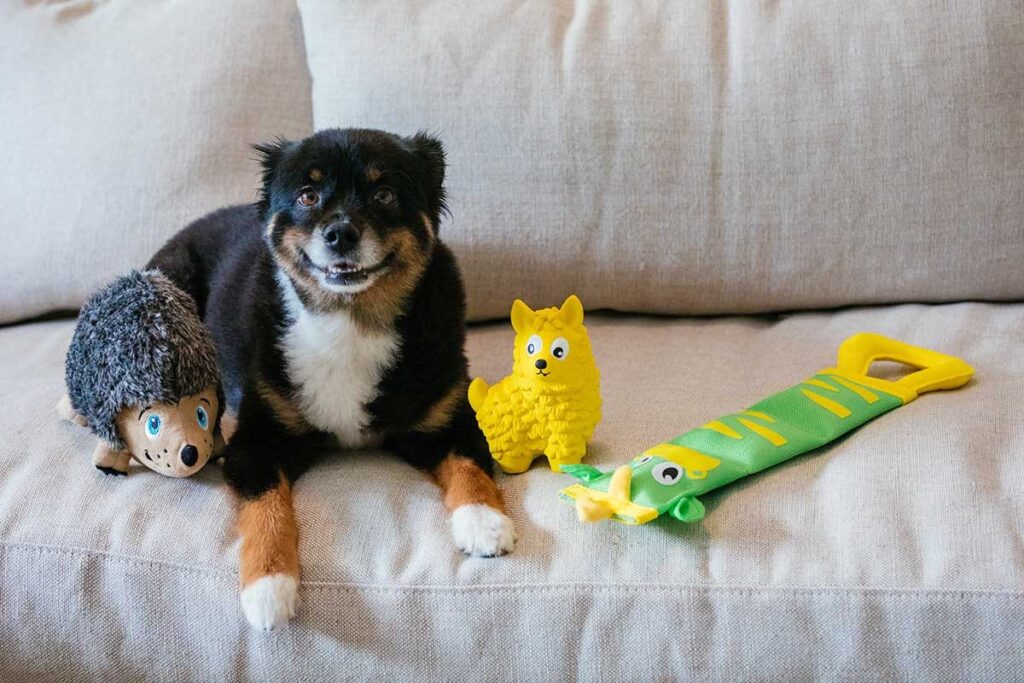You’ve probably heard about autism spectrum disorder or ASD, and you might know that it involves people who have challenges with communication and repetitive behaviors. But have you ever wondered if it is unique to humans?
Perhaps you’ve noticed certain behavioral problems in your dog and wondered, is there autism in dogs? Is there a form of canine autism, and if so, what does that look like? As it turns out, there is a form of autism in dogs, but first, let’s get the definitions straight.
What Is Autism?

The Centers for Disease Control and Prevention (CDC) defines autism spectrum disorder as a developmental disability that causes social, communication, and behavioral changes. Approximately 1 in 54 children in the United States is considered to be on the autism spectrum.
The symptoms of ASD begin in early childhood, with most diagnosed by age 2. It is possible for an adult to be diagnosed with autism as well. There are no medical tests for ASD. Instead, qualified medical professionals use behavioral screening to diagnose the problem.
The symptoms include avoiding eye contact, an inability to follow other people’s pointing cues, difficulty with social interactions, an inability to understand other people’s emotions, avoidance of physical contact, and obsessive and/or compulsive behaviors.
Autistic individuals also frequently get easily upset, particularly if something changes. They might also spin in circles or rock their body, and they can have problems with seizures, insomnia, and hyperactivity.
A diagnosis of autism is still somewhat controversial in humans, but what about dogs? Can they have a form of autism?
Is There Such a Thing as Canine Autism?

As it turns out, there is a form of canine autism called canine dysfunctional behavior, or CDB. As with humans, researchers are not certain what are the causes of autism in dogs, but it does appear to be congenital, meaning your dog is born with it.
Research into autism-like symptoms in dogs began in the 1960s. It appears that dogs with canine dysfunctional behavior lack what is referred to as mirror neurons in their brain. These mirror neurons help your dog learn social norms.
Without them, a dog is not able to develop important social skills in much the same way that humans with ASD are not able to learn vital human social skills. Much of the research into autism in dogs have focused on tail-chasing behaviors in bull terriers.
In one study, the researchers found that compulsive tail-chasing was also associated with trance-like behaviors and increased aggression. Moreover, they found that these behaviors were more prevalent in male dogs.
This research and subsequent studies have led the American College of Veterinary Behaviorists to conclude that such behaviors are, in fact, a form of autism spectrum disorder.
How Does Canine Dysfunctional Behavior Differ from Autism in Humans?

While there are similarities between human autism and canine dysfunctional behavior, there are also some differences. For one, it doesn’t appear that CDB has a spectrum like ASD, though that can be difficult to ascertain.
Mainly, veterinarians have to rely on comparing what is considered normal behavior with what is seen as abnormal. They are able to diagnose canine dysfunctional behavior based on repetitive, compulsive behaviors and impaired social interaction. Of course, they like to rule out any other medical conditions before they arrive at this diagnosis.
Dogs with canine dysfunctional behavior exhibit several autism-like behaviors such as antisocial behavior. They might not, for example, be able to pay attention to you when you’re on walks, during playtime, or when they’re being fed. They also might not want to interact with other dogs.
Communication, Stimuli Response, and OCD
Similarly, they often exhibit signs of obsessive-compulsive disorder (OCD). These can include obsessive tail-chasing, circling, chewing, or teeth grinding. Some dogs will even line up toys or other objects in a way that is very similar to the way some autistic children will do.
In both cases, this is often due to elevated levels of serum neurotensin and corticotropin-releasing hormone. These are secreted when the individual feels stressed.
One of the typical signs of autism in humans is problems with communication. Dogs with canine dysfunctional behavior might also have problems expressing their feelings. They might not, for example, wag their tail when they’re happy or put their ears back if you’re reprimanding them.
As with human autism, they may not make eye contact with you or other dogs. They also will sometimes enter what observers describe as a trance-like state.
Both humans and dogs will also exhibit inappropriate reactions to stimuli. For dog behavior, this means yelping when they are gently touched or expressing fear or aggression when you pat their heard.
Finally, your dog might avoid new environments and situations. If something new is introduced into their environment, they might immediately retreat to what they consider a safe space, such as under the bed.
Additionally, while it’s critical for your dog to get regular exercise, if he has dog autism, he may not be interested, even if he is a high-energy dog breed.
How Is Dog Autism Treated?

Autism in dogs is complicated as it is with humans, and there isn’t a single treatment. Your veterinarian will want to rule out any medical conditions that could be causing the behavioral symptoms. Once they have determined if your dog has canine dysfunctional behavior, there are a number of therapies they might recommend.
There are medications, such as Prozac, that can provide some relief for compulsive behaviors. These medications can also help with aggressive behaviors. It’s also important to make sure your dog has a safe space where he feels comfortable and calm.
As a good dog owner, you’ll also want to avoid situations that will induce anxiety, such as dog parks or busy streets. You don’t want to force your dog into situations that will trigger his stress.
It’s also important for your dog to get regular exercise to help reduce stress. It can be helpful to work with a dog trainer or veterinary behaviorist to use positive reinforcement to reduce and manage your dog’s canine dysfunctional behavior.
Do Vaccinations Cause Autism in Dogs?

While there has been much in the news about vaccinations causing human autism, there is no evidence this is true. There is no evidence in either dogs or humans that vaccinations have anything to do with the development of autism or canine dysfunctional behavior.
Moreover, vaccinations are well-documented to prevent many common, otherwise deadly diseases. Diseases that pose far more of a threat to your dog than getting a vaccination does.
The research in the field of veterinary medicine all points to underlying genetic predispositions that may result in a congenital condition in the presence of certain high-stress environments.
In short, although researchers cannot identify a single cause of autism in humans or dogs, there is no evidence to suggest vaccinations cause the problem. The research that claimed to show a connection has been discredited on numerous occasions. The doctor who made those false claims has been struck from the medical register and found to have had a profit motive for claiming there was a link.
Final Thoughts

If you suspect your dog has canine dysfunctional behavior or dog autism, you should contact your veterinarian to get a physical examination. Your vet may refer you to a board-certified veterinary behaviorist who can help determine your dog’s triggers.
They will also help you find ways to reduce your dog’s stress and, therefore, his dysfunctional behavior. These can include pressure wraps, such as ThunderShirts, that help calm your dog by applying pressure to his chest, calming treats and pheromones, and backpacks you can use to carry your dog to avoid triggering stimuli when you’re walking outside.
They might also recommend you ask people not to ring your doorbell if that’s something that triggers your dog, and you’ll definitely want your dog to have a safe space. It sounds like a lot, but when you’re helping out your best friend, it’s not so much to ask.

